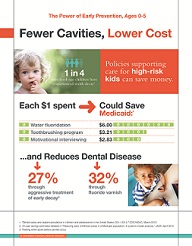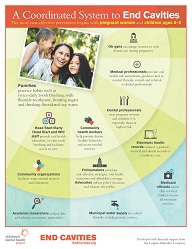A Coordinated System That Includes Fluoridation
Even though tooth decay is nearly always a preventable disease, nearly one in four preschool-age children have experienced a cavity. A new online resource points to the need for a “coordinated system” approach to make early childhood cavities a thing of the past. And community water fluoridation is a key part of this system.
EndCavities.org, a website launched this month by the Children’s Dental Health Project (CDHP), explains that keeping kids cavity-free during these early years can put them on a path to lifelong good oral health. The website links to two infographics that demonstrate the importance of fluoridation.
The first infographic on EndCavities.org identifies all of the people — including dentists, pediatricians and community health workers — who can play key roles to help children who are most at risk of tooth decay. This same infographic encourages families to take smart steps at home to keep their children cavity-free, including “habits such as twice-daily tooth brushing with fluoride toothpaste, limiting sugars and drinking fluoridated tap water.”
We know that untreated tooth decay can take a significant toll on children’s health and well-being, but early childhood cavities also take an economic toll. Both families and state budgets pay significant amounts of money when it becomes necessary to fill cavities or perform other dental treatments. The second infographic explains that by preventing cavities for low-income children ages 0-5, fluoridation saves a state Medicaid program $6 for every $1 spent on this practice.
Of course, fluoridation saves much more money if you include the impact for older children and for all adults. This web page summarizes the impressive overall savings from fluoridation.



